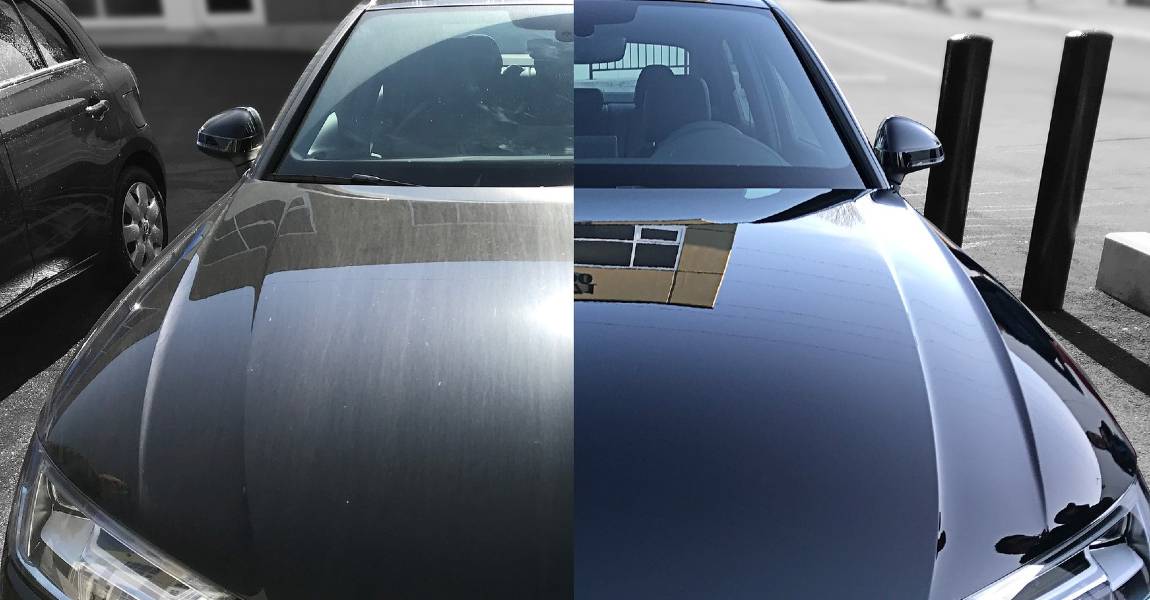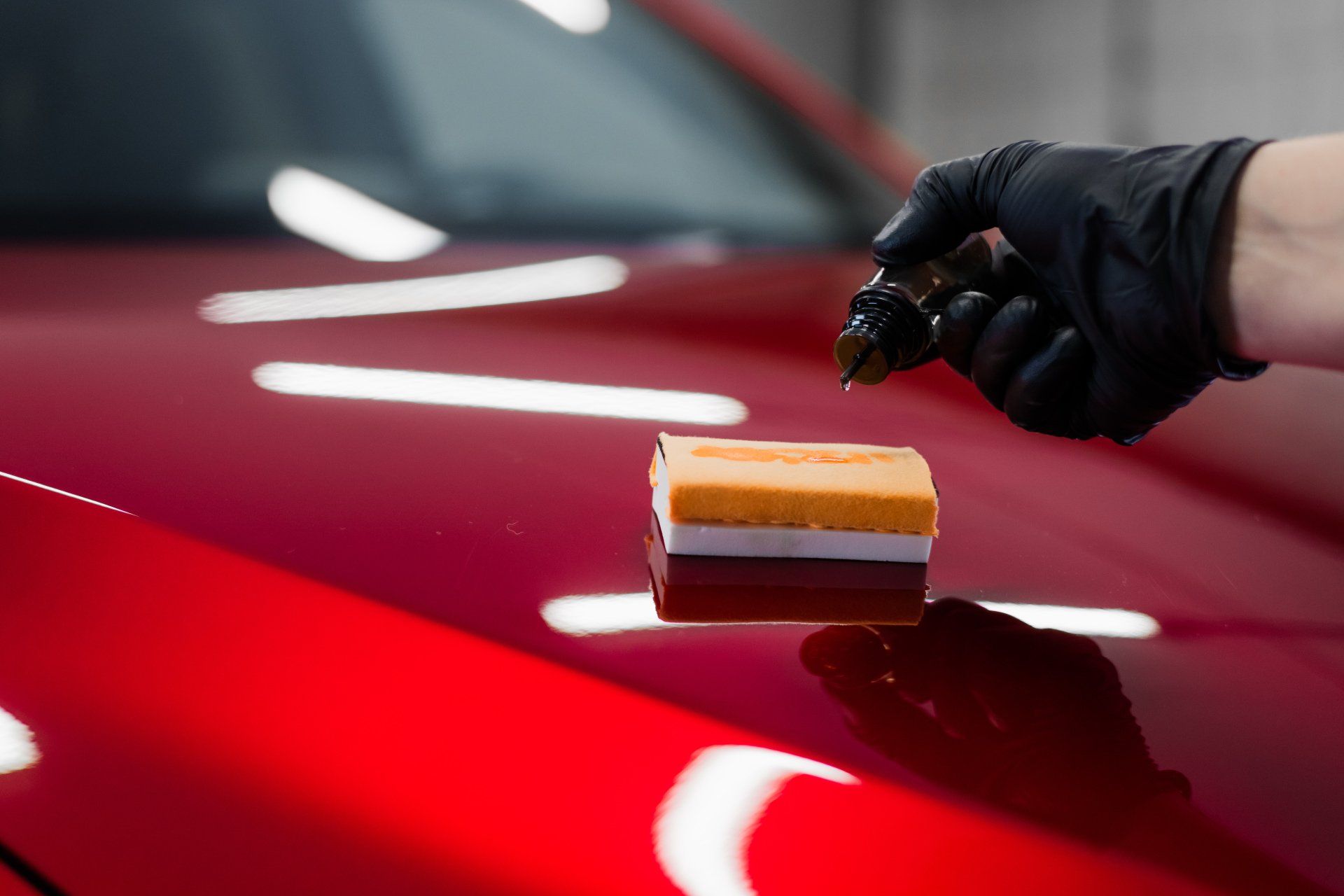The main factors to consider before getting Ceramic Coating Newark
Wiki Article
Checking out the Scientific Research Behind Car Ceramic Coating and Its Protective Features
The scientific research of car ceramic coating provides a remarkable study in innovative vehicle protection. Made up mainly of silicon dioxide and polymers, these finishings develop a robust bond with lorry paint. This interaction boosts sturdiness versus ecological hazards while providing hydrophobic advantages. The details of how these finishes work and their long-lasting benefits stay much less understood. Ceramic Coating Newark. Unpacking these information reveals why ceramic coatings are becoming a preferred choice for car treatmentWhat Is Ceramic Coating?
Ceramic coating is a fluid polymer that chemically bonds to the surface of a lorry's paint. This sophisticated safety layer improves durability and provides premium resistance to ecological aspects. Unlike conventional wax or sealants, which give short-term defense, ceramic finishings create a resilient guard that can stand up to severe problems such as UV rays, acidic contaminants, and extreme weather condition. When used appropriately, the coating forms a hydrophobic surface, triggering water to bead and slide off, which assists in keeping the vehicle's cleanliness. Furthermore, it supplies boosted gloss and depth to the paint, making the car appear even more refined and vibrant. The application procedure normally includes complete surface area preparation, including cleansing and sprucing up, to assure peak bonding. Therefore, ceramic coverings are becoming progressively popular among car fanatics and those seeking to shield their investments, guaranteeing to maintain the lorry's aesthetic allure while lowering the frequency of maintenance.The Composition of Ceramic Coatings
The elaborate formula of ceramic coverings largely contains silicon dioxide (SiO2), which is stemmed from natural resources like quartz and sand. This vital element supplies the foundation for the coating's longevity and safety top qualities. Along with SiO2, ceramic finishes commonly consist of various polymers and ingredients that improve bond, flexibility, and resistance to ecological aspects. These substances function synergistically to create a durable barrier versus contaminants such as dust, chemicals, and UV rays.Furthermore, some solutions incorporate titanium dioxide (TiO2) or other nanomaterials, which can boost the coating's hydrophobic residential or commercial properties, causing improved water repellency. The precise structure can vary substantially amongst makers, influencing efficiency and long life. Inevitably, the mix of these aspects culminates in a safety layer that not just boosts the aesthetic appeal of lorries however additionally serves to extend their life expectancy by securing the surface area from potential damages.How Ceramic Coatings Work
Recognizing just how ceramic coverings function entails discovering their chemical make-up, which adds to their safety qualities. The application procedure is necessary for attaining optimal outcomes, while longevity and resilience variables identify the coating's performance gradually. Together, these aspects highlight the advantages and performance of ceramic finishings for vehicle protection.Chemical Make-up Explained
While many car proprietors seek resilient defense for their lorries, the chemical make-up of ceramic coatings plays an essential role in their performance. These finishes largely include silicon dioxide (SiO2), which is acquired from all-natural minerals. This substance forms a strong bond with the car's paint, producing a durable, safety layer. In addition, several ceramic finishings consist of titanium dioxide (TiO2), improving their hydrophobic residential properties and resistance to UV rays. The presence of polysiloxanes can additionally improve versatility and longevity. With each other, these elements add to the coating's ability to ward off water, dust, and impurities, while additionally supplying a high-gloss coating. Comprehending this chemical foundation aids car proprietors appreciate the robust protection used by ceramic finishings.Application Process Overview
Using ceramic layers involves a precise process that assures suitable bonding and defense for the vehicle's surface. Originally, thorough cleansing and decontamination of the car's exterior are executed to get rid of dust, crud, and previous waxes. This action validates that the surface area is devoid of pollutants that could prevent adhesion. Following this, the paint is typically polished to enhance clarity and remove any blemishes. When prepared, the ceramic coating is used in little sections utilizing an applicator pad, enabling consistent insurance coverage. The coating is then entrusted to cure, forming a strong chemical bond with the surface area. Proper curing times and conditions are important, as they validate the coating achieves its optimum efficiency and protective high qualities.click this link
Durability and Longevity Variables
Ceramic finishes are created to supply long-lasting security via their sophisticated chemical structure, which produces a robust obstacle against environmental impurities. The longevity of these finishes is influenced by elements such as the density of the application, the top quality of the item, and the problems under which the automobile is exposed. Top notch ceramic layers can last a number of years, resisting scrapes, UV rays, and chemical spots. Appropriate upkeep, consisting of routine cleaning and regular reapplication, can further enhance durability. In addition, environmental elements like climate and direct exposure to contaminants can influence the life-span of the coating. Overall, when applied and preserved properly, ceramic layers offer outstanding durability, making them a popular choice for car lovers looking for to protect their automobile's look.Hydrophobic Characteristics and Water Repellency
Hydrophobic residential or commercial properties are a trademark of high quality car ceramic finishes, substantially improving the automobile's surface performance. These coatings develop a molecular bond with the car's paint, leading to a surface area that wards off water important site successfully. When water comes right into contact with a ceramic-coated surface, it beads up and rolls off, reducing the amount of liquid that continues to be on the paint. This habits not just adds to an aesthetically pleasing look however also minimizes the buildup of contaminants such as dirt, gunk, and roadway salts.The enhanced water repellency results in easier cleaning and maintenance, as much less effort is called for to get rid of unwanted compounds. On top of that, the hydrophobic nature of ceramic finishings aids in stopping water spots, which can mar the finish of uncoated surfaces. Generally, the unification of hydrophobic residential properties in ceramic finishings plays an essential function in maintaining the vehicle's immaculate appearance while streamlining maintenance.Defense Against Scratches and UV Damage
Car ceramic coverings offer substantial protection against scratches and UV damage. The scrape resistance mechanism creates a resilient layer that absorbs impacts, while the UV securing advantages aid maintain the lorry's paint honesty gradually. Together, these attributes add to a longer-lasting and aesthetically attractive coating.Scratch Resistance System
Making use of sophisticated modern technology, ceramic finishings give a robust shield versus scrapes and UV damage, improving the long life and look of car surface areas. The scrape resistance mechanism of these finishes is attributed to their distinct molecular framework, which creates a resilient bond with the automobile's paint. This bond develops a hard, protective layer that can soak up effects and withstand abrasions. Additionally, the smooth surface area of the coating decreases friction, making it challenging for contaminants to adhere and trigger scratches. The chemical structure of ceramic coverings often consists of nanoparticles that enhance the protective layer, more enhancing its durability. Cars treated with ceramic finishes display markedly enhanced scratch resistance contrasted to typical wax or sealers, ensuring a beautiful surface over time.UV Shielding Perks
The protective top qualities of ceramic layers expand past scrape resistance to include considerable UV protecting benefits. These coverings produce a robust obstacle that mirrors unsafe ultraviolet rays, safeguarding the lorry's paint and underlying materials. Prolonged direct exposure to UV radiation can cause fading, oxidation, and degeneration of the paint surface. By incorporating ceramic layers, automobile proprietors can successfully reduce these threats, maintaining the aesthetic appeal and integrity of their learn the facts here now cars. Additionally, the UV blocking buildings add to boosted durability, reducing the frequency of repainting and maintenance. Inevitably, the assimilation of ceramic finishings uses a comprehensive option for shielding lorries from the harmful results of sun direct exposure, guaranteeing a sustained, vibrant look gradually.The Durability and Upkeep of Ceramic Coatings

Frequently Asked Inquiries
Can Ceramic Coating Be Applied to Any Type Of Sort Of Vehicle?
Ceramic coating can be related to various sorts of lorries, including cars and trucks, vehicles, and bikes. Surface preparation and compatibility with specific materials are important for perfect adhesion and effectiveness of the coating.Just How Much Does Ceramic Coating Generally Cost?
Ceramic coating typically sets you back between $500 and $2,000, depending on aspects such as car size, coating top quality, and expert application. The investment can give durable defense and boost the automobile's appearance over time.
Is Expert Application Necessary for Best Outcomes?
The need of professional application usually depends on preferred outcomes. Specialists generally ensure correct surface area prep work and application methods, resulting in optimal bonding and long life of the coating, which might be challenging for inexperienced people to achieve.Can Porcelain Coatings Be Removed or Fixed?
Ceramic finishings can be removed or fixed, though the procedure might call for specific solvents or techniques - Ceramic Coating Newark. Appropriate elimination is essential to prevent damages to the underlying surface area, stressing the value of expert aid for optimal outcomesHow Does Porcelain Coating Contrast to Typical Wax?
The contrast between ceramic coating and traditional wax discloses that ceramic coatings offer superior sturdiness, improved protection versus ecological contaminants, and longer-lasting luster, while wax calls for extra regular application and supplies much less general resistance to damages.Report this wiki page